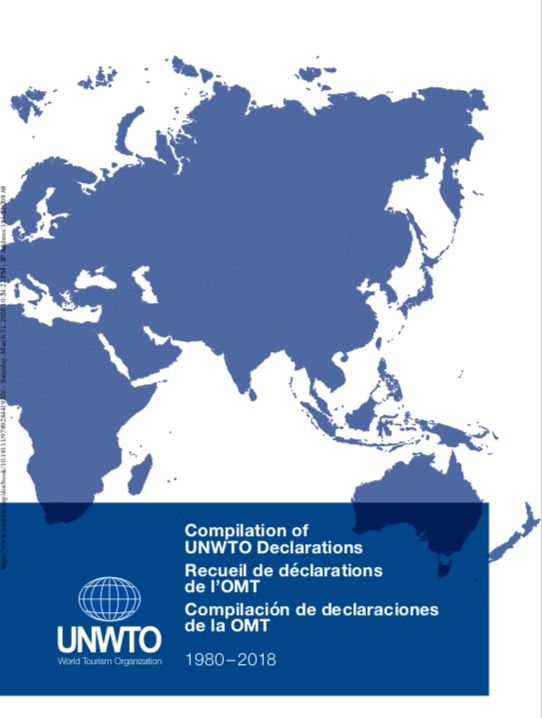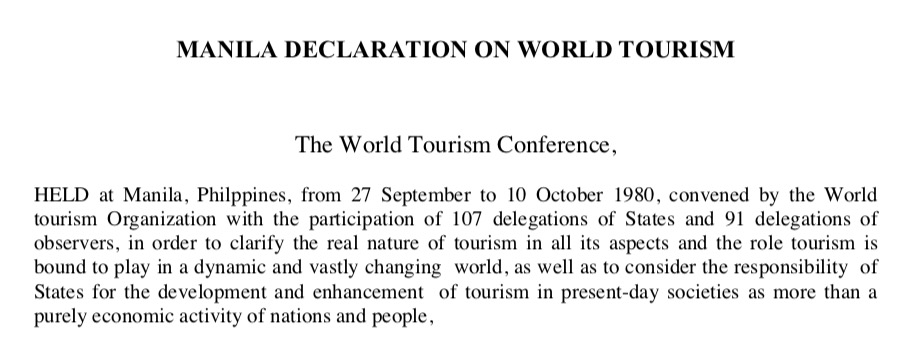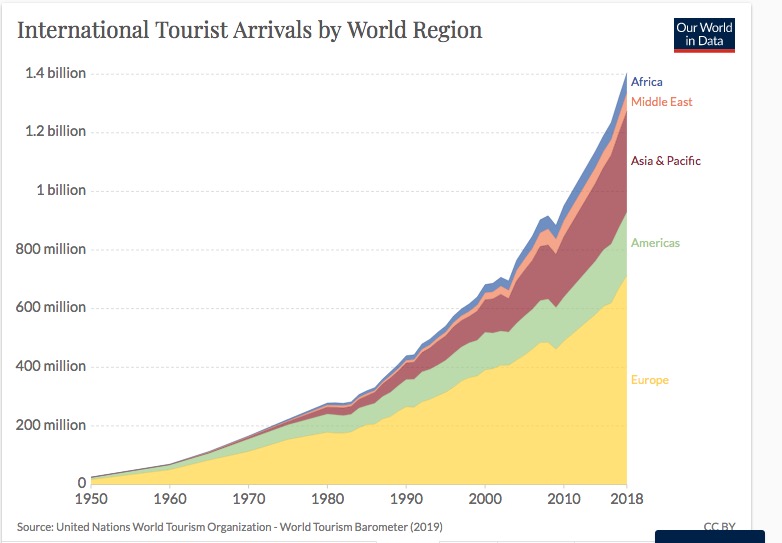
2 Jul, 2020
1980 UNWTO Manila Declaration Shows How Global Travel & Tourism Failed Its Mandate and Vision
Bangkok – In hot pursuit of REcovery from the devastation caused by Covid-19, global Travel & Tourism is abuzz with “New Normal” buzzwords: REthink, REbuild, REdesign, REform, REimagine, REinvent, RE-this and RE-that. A better option would be to press the REwind button and REflect on its own history, especially the failures and mistakes. If the industry’s self-proclaimed visionaries and thought-leaders care to do that, I would REcommend REversing to 1980 and hitting REplay.
Up until January 2020, the first month of the third decade of the 21st Century, global Travel & Tourism was flush with success. Visitor arrivals were skyrocketing, along with economic performance, jobs and GDP. However, if the measurement indicators are REadjusted and expanded to include the side-effects of tourism growth, the shine begins to come off. It is only by REvamping all its past measurement indicators that Travel & Tourism will assure itself a more stable, sustainable, safe and secure “New Normal.”
Exactly 40 years ago, tourism leaders from 107 countries convened for a World Congress in Manila, the Philippines, under the aegis of the UN World Tourism Organisation. The historic meeting came at a pivotal moment. The Philippines was a rising tourism destination. The Indochina wars had just ended. Paid-leave and annual vacations had become the “New Normal” in the industrialised countries. The wide-body Boeing 747 and McDonnell-Douglas DC-10 jets, both capable of carrying 300+ passengers non-stop over long haul distances, were ushering in the era of mass travel.
Citing these growth-generating “New Normal” trends, the World Congress ended with a watershed document, the Manila Declaration. It was not another motherhood-and-apple-pie statement applauding the growth to come. In a true assertion of original thought-leadership, the World Congress sought to raise the bar and envision the future of tourism from a much more holistic, comprehensive and philosophical perspective. Delegates saw its potential as a conduit for peace, harmony and the betterment of humanity, the advancement of human dignity, all well beyond the parochialism of economic growth. Simultaneously, they also saw its pitfalls, and sounded clear warnings about it.
The Manila Declaration is the lead item in a compilation of UNWTO communiques and resolutions over the period 1980-2019. They are all non-binding statements affirming a common desire by their signatories to address the challenges and opportunities of the time. Although hundreds of tourism conferences have issued numerous “calls to action”, over many decades, they never seem to REwind the clock and analyse the progress (or lack of it) made in fulfilling past pledges and “calls to action”.

Precisely because of that lapse, past mistakes are glossed over. And precisely for that reason, they get REpeated.
Today, the Manila Declaration is probably the most relevant “Old-and-New Normal” manifesto in existence. The current crop of gurus and instant experts claiming to be oracles of wisdom on tourism are offering nothing that even remotely comes close. I doubt any of today’s tourism ministers, policy-makers, CEOs, futurists have heard of it. If they read, nay study, the Declaration, they may realise how the industry lost sight of its original virtuous vision. They may save a lot of time, money and grief by REsurrecting the Declaration and putting its principled keypoints at the core of all future tourism strategies.
The most significant aspect of the Declaration is that its authors warned against making economic and commercial benefits the be-all and end-all of tourism development. Doing so, they warned, would lead to “harmful distortions”.
Its very first para stresses the breadth and depth of what was then also emerging as a “New Normal”, and asserts that Travel & Tourism must be treated “as more than a purely economic activity.”

The declaration refers to the role of world tourism as “a vital force for world peace and can provide the moral and intellectual basis for international understanding and interdependence.” Tourism is described as an “an activity essential to the life of nations because of its direct effects on the social cultural, educational and economic sectors of national societies and their international relations….Its very existence and development depend entirely on the existence of a state of lasting peace, to which tourism itself is required to contribute.”


The Declaration talks of the “cultural and moral dimension” of tourism. It recognises travel “as an aspect of the fulfillment of the human being”, a means by which people can get get to know their own environment and develop a deeper awareness of their national identity.” It talks of social tourism to help the least privileged also “exercise of their right to rest.” It refers to tourism as a contributor to the physical and mental health of individuals, especially young people, the elderly and the handicapped. It hails tourism “as a positive and ever-present factor in promoting mutual knowledge and understanding and as a basis for reaching a greater level of respect and confidence among all the peoples of the world.”

“In the universal efforts to establish a new international economic order, tourism can, under appropriate conditions, play a positive role in furthering equilibrium, cooperation, mutual understanding and solidarity among all countries,” the Declaration says.
It also establishes a clear balance between the economic and ecological aspects of tourism, thus:

Significantly, it says, “In the practice of tourism, spiritual elements must take precedence over technical and material elements,” and then goes on to describe what comprises “the spiritual elements.”
Even more significantly, it warns against making economic returns of tourism “the only criterion” for states to encourage it.

It then issues a Call to Action.
The Declaration “strongly urges” all the participating States, together with the UNWTO, “to take into account the guidelines, viewpoints and recommendations emanating from the Conference so that they can contribute, on the basis of their experience and in the context of their day-today activities, to the practical implementation of the objectives set with a view to broadening the process of development of world tourism and breathing new life into it.”
It also urges the World Tourism Organization to take all necessary measures, both internally and in cooperation with other international, intergovernmental and non-governmental bodies, so as to permit the global implementation of the principles, concepts and guidelines contained in this final document.
So here’s the challenge for the UNWTO leaders and tourism ministers. Since 1980, has the Declaration fulfilled its mandate and its vision?
In 1980, global tourist arrivals totalled 287 million. In January 2020, the UNWTO grandiosely announced, “1.5 billion international tourist arrivals were recorded in 2019, globally. A 4% increase on the previous year which is also forecast for 2020.”
If tourism has grown so spectacularly in the past four decades, has the world become a more peaceful, safe, socially and culturally cohesive place? Has there been a commensurate increase in respect for human dignity and environmental consciousness? Has its cultural and moral dimensions been fostered and protected against the harmful distortions which can be brought about by economic factors? How can the rise in tourism be explained against the commensurate rise in racism, ethnocentricism, nationalism, wars and economic disparities?

A hard nosed evaluation, given the state of both the tourism and the world today, would show that economic and commercial priorities have hijacked and sidetracked the agenda. It’s easy to understand why. They drive political and corporate agendas. CEO pay packages are decided on the basis of their ability to meet financial targets. Ministers are evaluated on the basis of their ability to drive visitor arrivals. None are ever evaluated on their contribution to enhancing peace and understanding, social and cultural cohesion. Measuring these supposedly abstract ideas is still an inexact science. On the other hand, there is no shortage of ways to measure job creation, visitor expenditure, asset value, shareholder returns, etc.
The first half of 2020 has ushered in a new era for Travel & Tourism. What happens in the second half could determine the future of the 21st Century. So far the Travel & Tourism resilience-and-recovery orchestra is singing the same tune — plenty of calls for bailouts and travel bubbles, technological fixes and marketing gimmicks. But no talk of peace-building, cultural cohesion or any of the perceptive agenda items of the Manila Declaration.
Which is why the same old cycle will turn again, until the next crisis. As has been the case since 1980, those who don’t learn the lessons of history are doomed to repeat it.



Liked this article? Share it!